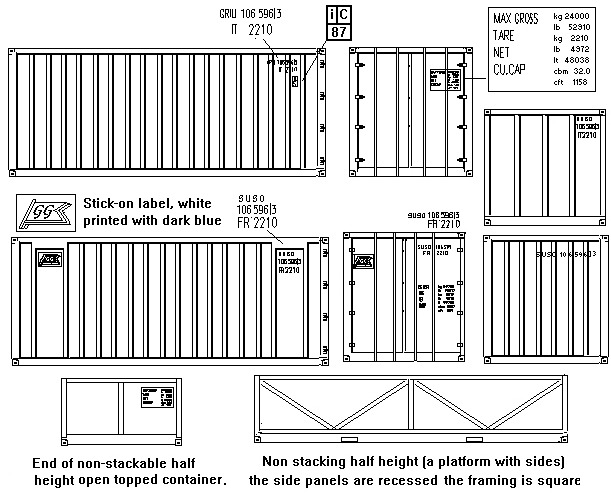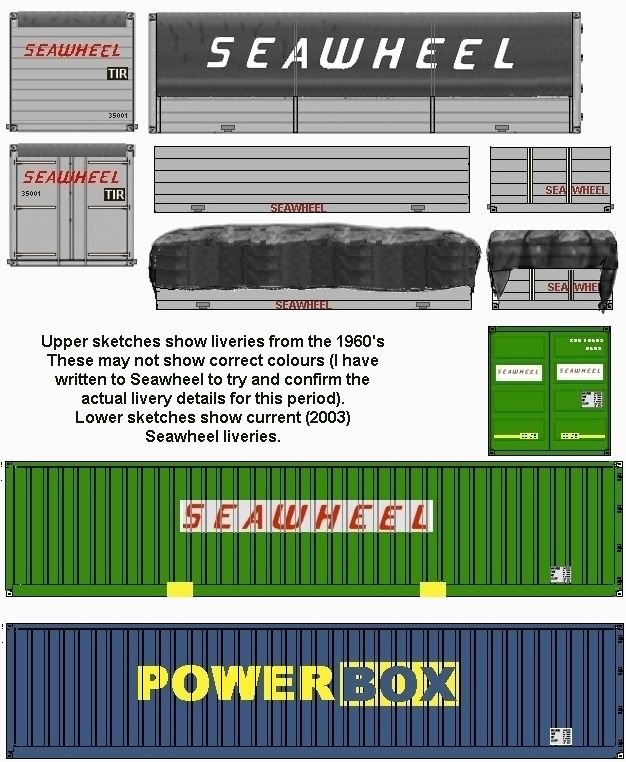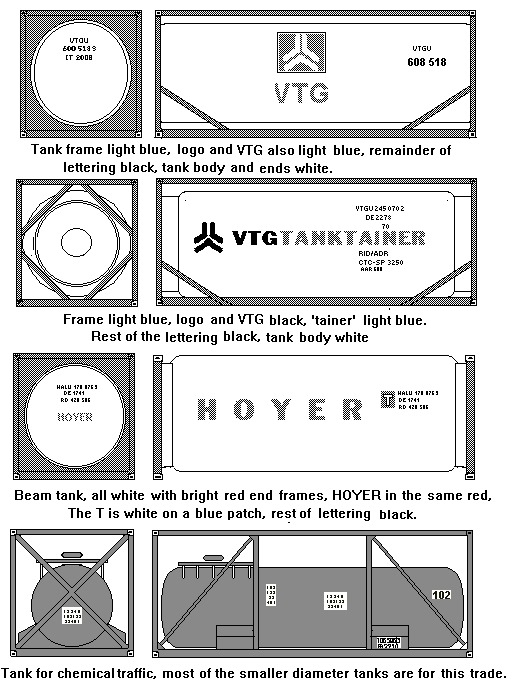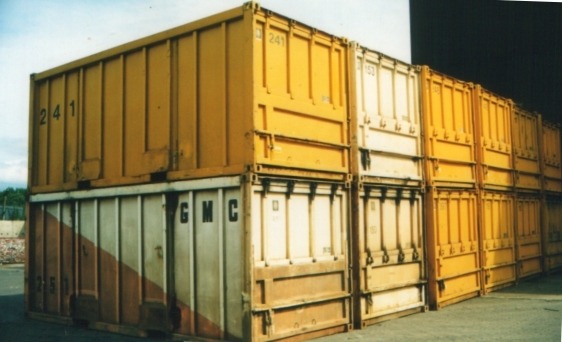Standard ISO container liveries
NB The colours used were obtained by sampling colour pictures, they
may however vary from the true colour, use as a rough guide only
In Britain ISO containers are owned by either Freightliners Ltd or by
private owners. The Freightliner liveries are discussed in detail in the
Operations - Freightliners section. The majority of containers were private
owner types by the mid 1980's with widely varied liveries, including
interesting variants such as the tank and flat containers. As yet none of these
odd container types are available in model form. Graham Farish produce
unpainted twenty and thirty foot ISO containers (the thirty foot type are
rather rare in practice), and transfers are available from commercial sources.
The range of modern image rolling stock kits from Bernard Taylor includes
modern steel open-topped coal containers. Many of the containers operated by
leasing companies are painted in a plain overall colour so that hiring firms
can apply self adhesive company markings as required. Every international
container carries three codes which identify it, there is a four letter code to
identify the owning company, a seven digit number which identifies the
container itself and the third code consists of two letters and four numbers,
the letters identify the country in which the container is registered (IT for
Italy, FR for France etc.). Containers used for international work also display
the TIR plate, which is used to indicate that the container has been checked by
customs at the point of loading and need not be checked at the border (if not
it will be checked by a customs official closer to its final destination). The
plate is white and the lettering is black, Freightliner containers, intended
for purely internal use did not have the TIR plate. If the TIR system is not
being used a small metal bar is swung across the plate to indicate that the
rules do not apply.
Fig ___ Basic ISO Container Markings

One company that has been associated with the ISO container from
its introduction is Seawheel, specialising in European and Irish traffic this
company has consistently been at the cutting edge of container technology and
is one of the major player in the European market today. The sketches below
were taken from photographs, the earlier examples were sketched from
photographs on Paul Bartlett's web site (see App 7 Useful Links) but I am
trying to confirm the exact colours used for these early containers. The lower
sketches show current Seawheel liveries, I believe these more modern containers are built to the non ISO European standard, designed to take the standard Euro-pallet.
Fig ___ Seawheel ISO and non ISO Container Liveries

Tank containers are comparatively rare, looking at aerial photographs of
container handling ports you will see perhaps one tank type for every hundred
or so closed box types. In traffic however they often travel in two's and
three's in Freightliner trains. Most tanks are rather plain, usually white
sometimes silver, but the frame might be blue, red or grey in colour. The tanks
have the registration numbers and capacity details on their ends, the
registration codes are displayed on the sides but most tanks do not have the
capacity information on their sides.
Fig ___ ISO Tank Container Markings

One new development in the late 1970's was the movement of compressed
waste from London to the landfill sides for disposal. In the 1980's other large
conurbation's also introduced similar operations, Bristol and Manchester
certainly introduced such services and possibly others. These trains use
Freightliner type flat wagons but the container flat wagons are all privately
owned or leased. London, Greater Manchester and Bristol (Avon Metropolitan) all
operated such systems at the present, and other towns are considering the idea.
Although resembling Freightliner trains, being `block trains of containers on
flats', these waste movement operations fall under the control of Railfreight
Construction sector.
The 'easidispose' containers used on the prototype operations have
distinctive external ribbing, but these could be made up from Graham Farish
unpainted containers or the kits of containers available from America. The
Greater Manchester examples were initially painted in the county colours (pale
cream and an indescribable orange, the result of a competition amongst school
children I believe), with GMC painted in black towards the upper left in
letters about 12 inches (30 cm) high. The London based containers were yellow
with GLC either centrally on the side of the container, or in a vertical line
(G at the top) in the last bay on the side. In the early 1990's there were
still a large number of waste containers in these original liveries but
following experiments with a white and yellow scheme Manchester at least has
opted for all yellow with black lettering.
Fig___ Manchester Waste Containers showing original 1980's
and later 1990's livery

^
Go to top of page
International Good Guys ~ Making the world a
better place since 1971 ~ Site maintained by

All material Copyright © Mike
Smith 2003 unless otherwise credited



